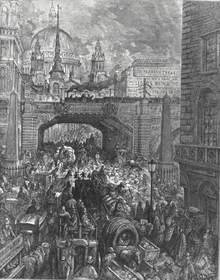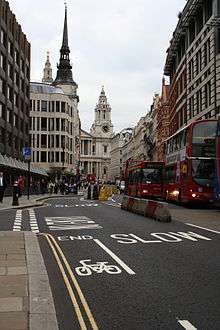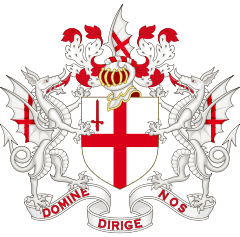Ludgate Hill

Ludgate Hill is a hill in the City of London, near the old Ludgate, a gate to the City that was taken down, with its attached gaol, in 1780. It is the site of St. Paul's Cathedral, traditionally said to have been the site of a Roman temple of the goddess Diana. It is one of the three ancient hills of London, the others being Tower Hill and Cornhill. The highest point is just north of St. Paul's, at 17.6 metres (58 ft) above sea level.[1]

Ludgate Hill is also the name of a street which runs between St. Paul's Churchyard and Ludgate Circus (built in 1864), from where it becomes Fleet Street. It was formerly a much narrower street called Ludgate Street.
Many small alleys on Ludgate Hill were swept away in the late 1860s to build Ludgate Hill railway station between Water Lane and New Bridge Street, a station of the London, Chatham and Dover Railway. It was closed in 1923 and the railway bridge and viaduct between Holborn Viaduct and Blackfriars stations was demolished in 1990 to enable the construction of the City Thameslink railway station in a tunnel. This also involved the regrading of the slope of Ludgate Hill at the junction.
There is a blue plaque near the bottom of the hill with these words: "In a house near this site was published in 1702 The Daily Courant first London daily newspaper".
About halfway up Ludgate Hill is the church of St. Martin, Ludgate, once physically joined to the Ludgate.
Paternoster Square, home of the London Stock Exchange since 2004, lies on the hill, immediately to the north of St. Paul's Cathedral.
Etymology
Ludgate is generally accepted to derive from the Old English term "hlid-geat"[2][3][4][5][6] from "hlid" ("lid, cover, opening, gate")[7] and "geat" or "gæt" ("gate,[2] opening, passage")[8] and was a common Old English compound meaning "postern" or "swing gate"[2][3][4][6] and survives in various place names across England[4] as well as in surnames.[9]
Literary associations
Ludgate is mentioned in Geoffrey of Monmouth's Historia Regum Britanniae, written around 1136. According to the pseudohistorical work[10][11] the name comes from the mythic Welsh king Lud son of Heli whom he claims also gave his name to London.[12]
The Cronycullys of Englonde tell us of an early king of Britain: "he lete make a fayre gate and called hit Lud Gate after his name" in the year 66 BC, but it is more likely that the Romans were the first to build it, and that it is simply named after him. One proposed derivation, entirely prosaic, is that the name is a variation on "Fleodgaet", or "Fleet-gate".
At the bottom of Ludgate Hill, on the north side, is Limeburner Lane. This may sound like a quaint survival from medieval times, but it was actually constructed in the 1990s, where Seacoal Lane used to be. This was the location of the Bell Savage Inn, first mentioned in 1452 where plays were performed. According to surveyor John Stow the name was derived from Isabella Savage, but Addison claimed it was "La belle Sauvage", a woman in the wilderness. The clown Richard Tarlton used to perform here. It is mentioned in Thomas Hughes' Tom Brown's Schooldays and Charles Dickens' The Pickwick Papers. In October 1684, a "Rynoceros lately brought from the East Indies" was put on show there.[13] The inn was demolished in 1873. In 1851, part of it was rented out to John Cassell (1817–1865), a notable publisher. At this time it was still called La Belle Sauvage Yard and the firm of Cassell used "la Belle Sauvage" in some of their imprints.
Thomas Malory was imprisoned in the Ludgate prison in the 1460s, and translated a French life of King Arthur while he was there. He later wrote Le Morte d'Arthur. The prison is mentioned in Daniel Defoe's Roxana: The Fortunate Mistress.
From 1731, the "London Coffee House" was next to St. Martin's, Ludgate, at 24-26 Ludgate Hill. It was frequented by Joseph Priestley and Benjamin Franklin. When the juries at the Old Bailey failed to reach a verdict, they were housed here overnight. In 1806, a Roman hexagonal altar dedicated to Claudia Martina by her husband, now in the Guildhall, was found here together with a statue of Hercules.[14] The London Coffee House was closed in 1867, and is now occupied by a pub called "Ye Olde London".
Edmund Spenser's "Shepheard's Calender" was printed by Hugh Singleton at the sign of the "Gylden tunne" in Creed Lane in 1579. John Evelyn lived in the Hawk and Pheasant on Ludgate Hill in 1658-59.
The Blackfriars, or Dominicans, first came to London in 1221. In 1278, they moved from Holborn to an area south of Ludgate, where they built a friary. By 1320, they had demolished the Roman wall to build a new wall for the friary. This was demolished at the Reformation, but the name persisted, when Shakespeare built the "Blackfriars Theatre" in 1596. In 1613, Shakespeare bought the Blackfriars gate-house.
Pageantmaster Court is almost opposite St. Martin's. The name is not medieval but dates from 1993. However, to the west is King's Arms Court, which existed until recently. Grinling Gibbons lived there. According to Stow, the gate acquired statues in 1260. In the reign of Edward VI the heads were "smitten off" and a few years later "Queen Mary did set new heads upon their old bodies again".[15]
References
- ↑ Ordnance Survey data
- 1 2 3 Charters of Abingdon Abbey, Volume 2,Susan E. Kelly, Published for the British Academy by Oxford University Press, 2001, ISBN 0-19-726221-X, 9780197262214, pp.623-266
- 1 2 Geographical Etymology, Christina Blackie, pp.88
- 1 2 3 English Place-Name society, Volume 36, The University Press, 1962, pp.205
- ↑ Middle English Dictionary, University of Michigan Press, 1998, ISBN 0-472-01124-3 pp. 972
- 1 2 An encyclopaedia of London, William Kent, Dent, 1951, pp.402
- ↑ http://www.etymonline.com/index.php?term=lid
- ↑ http://www.etymonline.com/index.php?term=gate
- ↑ http://www.surnamedb.com/Surname/Ludgate
- ↑ Wright, Neil (1984). The Historia Regum Britannie of Geoffrey of Monmouth. Woodbridge, England: Boydell and Brewer. pp. xvii–xviii. ISBN 978-0-85991-641-7.
- ↑ "...the Historia does not bear scrutiny as an authentic history and no scholar today would regard it as such.": Wright (1984: xxviii)
- ↑ Ackroyd, Peter (2001-12-02). "'London'". New York Times. Archived from the original on 15 April 2009. Retrieved 2008-10-28.
- ↑ The London Gazette of 10 October 1684
- ↑ Ref 1 below
- ↑ Brewer, Ebenezer Cobham. Dictionary of Phrase and Fable. London: Cassell and Company, 1905. Page 780.
External links
- Hercules statue ref (1)
- Ludgate statues Ref (2)
- Leigh Hunt's description
- Ludgate hill in Dictionary of London (1918) British History Online
- Illustration
- Gazeteer
- David Nash Ford, "Roman London"
- Ludgate Hill pubs & City of London pubs
Coordinates: 51°30′49″N 0°06′04″W / 51.5137°N 0.101°W
